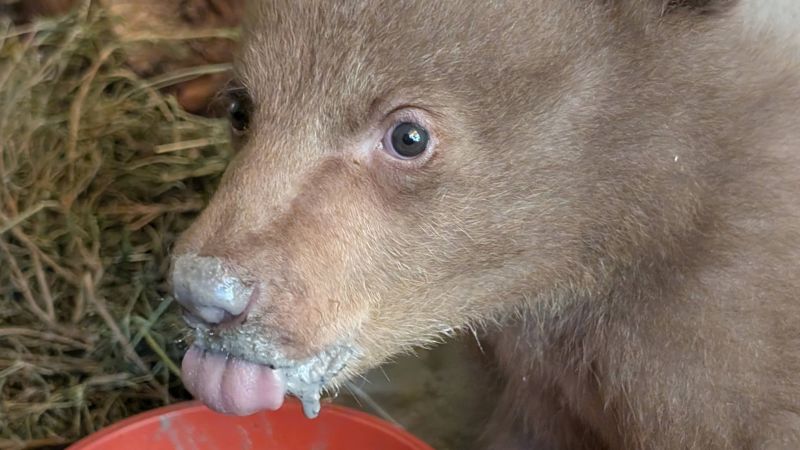CNN
—
Gloves, a fur coat and a bear mask. This outfit might sound like avant-garde fashion, but it’s actually the uniform of caretakers at the San Diego Humane Society who are raising an orphaned black bear cub.
Campers in California’s Los Padres National Forest found the cub in April. Biologists from the state’s Department of Fish and Wildlife tried looking for the cub’s mother for several days. After no sign of her, the humane society took him in.
The cub, who was nearly two months old when he was taken in, is the youngest black bear the organization has ever cared for, according to Autumn Welch, the society’s wildlife operations manager and one of the cub’s caregivers.
“At that age, he would be with his mom 24/7 and not really venture away from the den,” Welch said. “He definitely wouldn’t have been able to survive on his own, so he most likely will be in rehab for about a year.”

The goal is to eventually release the cub back into the wild, so the bear costumes worn by his caretakers reduce the risk of him imprinting on humans.
But do the costumes actually convince the cub he’s being taken care of by other bears?
According to Welch, they do. She said that caregivers recently performed a test by entering his enclosure without the costume to make sure the cub is not identifying them as humans.
“He was afraid and ran up the tree,” Welch said. “That’s what we want.”
The caregivers wear real fur coats that were donated to the humane society, Welch said. To make the costumes even more believable, the furs are stored in sealed containers with hay sourced from a local wildlife sanctuary that also houses bears. She said the hay helps the furs have a black bear scent.
“Now, we don’t know if he looks at us as like surrogate mamas,” she said. “I feel like it’s more like we are his playmates, like his siblings, that are coming in and if he does want to play with us, we redirect him to his teddy bears.”
Along with teddy bears, the cub’s enclosure is also filled with donated furs, black bear-scented hay, trees and plenty of places for him to climb and hide to simulate a den, Welch said.
The cub sleeps on and hides under one of the larger teddy bears, which Welch thinks he sees as his mother.

“This large teddy bear was something that provided him comfort,” Welch said. “When we were not there, he would seek shelter by her, go rest against her, take naps all cuddled up with the bear.”
The caregivers use their time in the cub’s enclosure to teach him skills that his mother would have taught him, like how to climb, how to find grasses and insects to eat and how to build a nest, Welch said.
“It’s been wonderful to see him hit various milestones,” she said. “I remember the first time he ate a bug, he dug through the dirt and picked out a beetle and ate it, which was great.”

The staff at the San Diego Humane Society isn’t the first to suit up to take care of orphaned wildlife. Employees at the Richmond Wildlife Center in Virginia wore a fox mask while caring for an orphaned kit. At the Wildlife Midlands Centre in South Africa, an employee used a makeshift crane costume to teach an orphaned chick how to drink water.
Welch said wearing a mask to take care of young wildlife is a strategy that they’ve used when bottle feeding baby raccoons and coyote pups. She said it’s important since young wildlife is very impressionable.
Since they have never cared for such a young bear, they had to order supplies, including the bear masks. Welch estimates it will cost $72,000 to take care of the cub for a year.
“It’s a labor of love,” she said. “We are happy to help these animals and get them back out and someday see him thrive in the wild — it’s going to be the best thing ever.”

